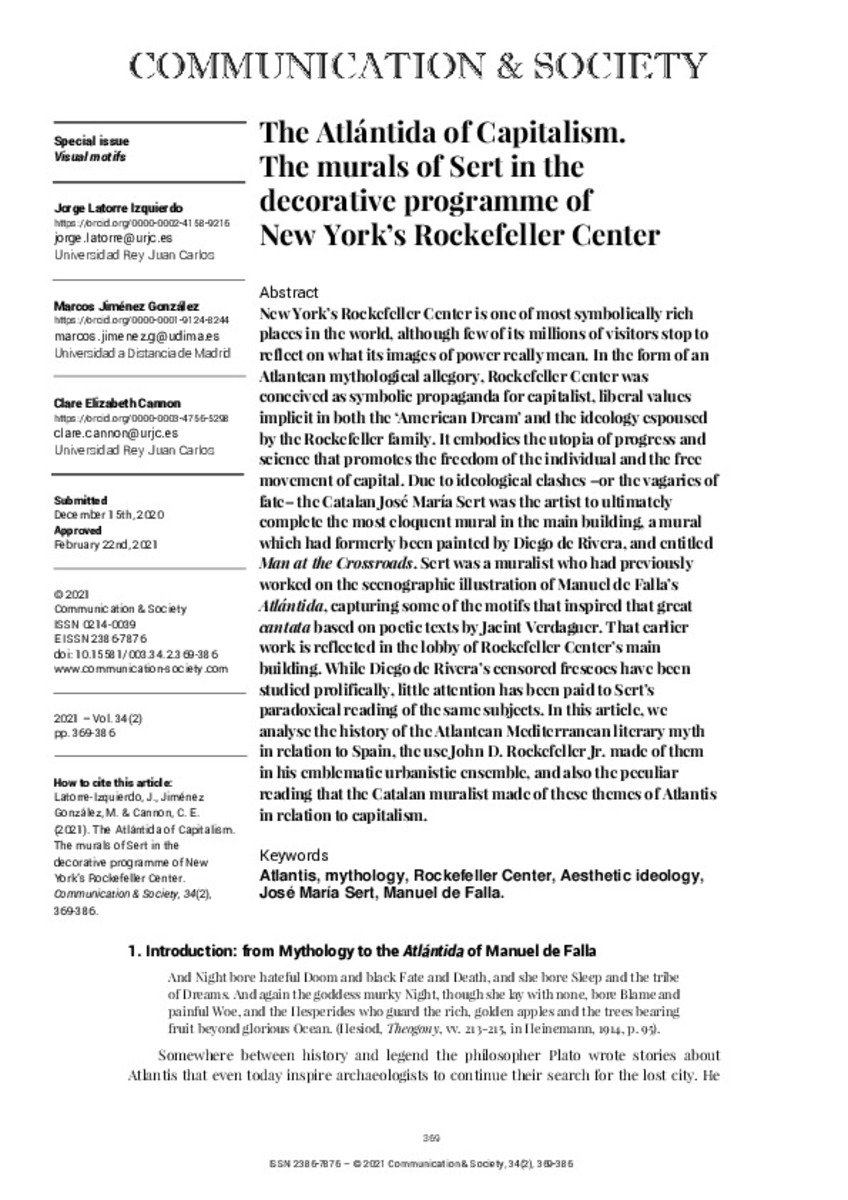Full metadata record
| DC Field | Value | Language |
|---|---|---|
| dc.creator | Latorre-Izquierdo, J. (Jorge) | - |
| dc.creator | Jiménez-González, M. (Marcos) | - |
| dc.creator | Cannon, C.E. (Clare Elizabeth) | - |
| dc.date.accessioned | 2021-04-13 | - |
| dc.date.accessioned | 2021-10-22T07:02:19Z | - |
| dc.date.available | 2021-10-22T07:02:19Z | - |
| dc.date.issued | 2021 | - |
| dc.identifier.citation | Latorre-Izquierdo, J. (Jorge); Jiménez-González, M. (Marcos); Cannon, C.E. (Clare Elizabeth). "The Atlántida of Capitalism. The murals of Sert in the decorative programme of New York’s Rockefeller Center". Communication & Society. 34 (2), 2021, 369 - 386 | es |
| dc.identifier.issn | 2386-7876 | - |
| dc.identifier.uri | https://hdl.handle.net/10171/62259 | - |
| dc.description.abstract | New York’s Rockefeller Center is one of most symbolically rich places in the world, although few of its millions of visitors stop to reflect on what its images of power really mean. In the form of an Atlantean mythological allegory, Rockefeller Center was conceived as symbolic propaganda for capitalist, liberal values implicit in both the ‘American Dream’ and the ideology espoused by the Rockefeller family. It embodies the utopia of progress and science that promotes the freedom of the individual and the free movement of capital. Due to ideological clashes –or the vagaries of fate– the Catalan José María Sert was the artist to ultimately complete the most eloquent mural in the main building, a mural which had formerly been painted by Diego de Rivera, and entitled <em>Man at the Crossroads</em>. Sert was a muralist who had previously worked on the scenographic illustration of Manuel de Falla’s <em>Atlántida</em>, capturing some of the motifs that inspired that great <em>cantata</em> based on poetic texts by Jacint Verdaguer. That earlier work is reflected in the lobby of Rockefeller Center’s main building. While Diego de Rivera’s censored frescoes have been studied prolifically, little attention has been paid to Sert’s paradoxical reading of the same subjects. In this article, we analyse the history of the Atlantean Mediterranean literary myth in relation to Spain, the use John D. Rockefeller Jr. made of them in his emblematic urbanistic ensemble, and also the peculiar reading that the Catalan muralist made of these themes of Atlantis in relation to capitalism. | en_US |
| dc.language.iso | eng | - |
| dc.publisher | Servicio de Publicaciones de la Universidad de Navarra | es_ES |
| dc.rights | info:eu-repo/semantics/openAccess | es_ES |
| dc.title | The Atlántida of Capitalism. The murals of Sert in the decorative programme of New York’s Rockefeller Center | en_US |
| dc.type | info:eu-repo/semantics/article | es_ES |
| dc.identifier.doi | 10.15581/003.34.2.369-386 | - |
| dadun.citation.endingPage | 386 | - |
| dadun.citation.number | 2 | - |
| dadun.citation.publicationName | Communication & Society | - |
| dadun.citation.startingPage | 369 | - |
| dadun.citation.volume | 34 | - |
Files in This Item:
Statistics and impact
Items in Dadun are protected by copyright, with all rights reserved, unless otherwise indicated.






